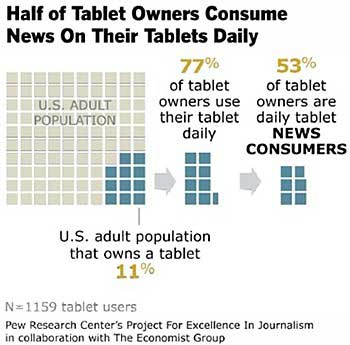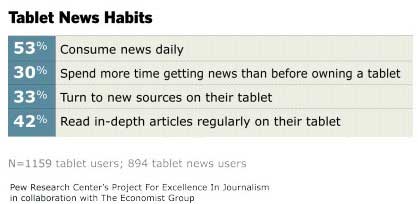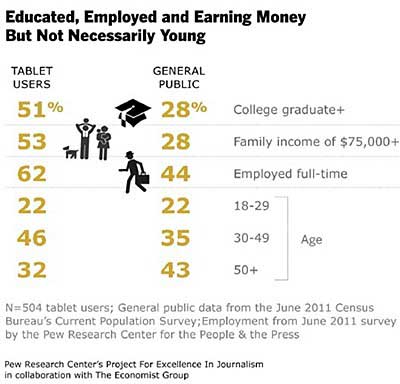Some 18 months after the introduction of the iPad, 11% of US adults now own a tablet computer of some kind, and among them 53% access news via tablet every day, reading long articles as well as browsing headlines, according to a new report by Pew Research.
Moreover, fully 77% of tablet owners use their tablet every day, spending an average of 90 minutes on their device.

Below, additional findings from a report titled "The Tablet Revolution and What it Means for the Future of News," conducted by the Pew Research Center's Project for Excellence in Journalism in collaboration with The Economist Group.
How People Use Tablets
Consuming news (everything from the latest headlines to in-depth articles and commentary) ranks as one of the most popular activities on the tablet, about as popular as sending and receiving email (54% email daily on their tablet); the only activity that people said they were more likely to do on their tablet computer daily is browse the Web generally (67%).
Even so, consuming news via tablet is more popular on a daily basis than social networking (39%), gaming (30%), reading books (17%), and watching movies and videos (13%).
One-third (33%) of tablet news users say they are turning to new sources for news on their tablet, sources they had not turned to on other platforms such as television or their desktop computer. And, more than four in ten (42%) say they regularly read in-depth news articles and analysis on their tablet.

Substitution Occurring
Most tablet users have already shifted their news consumption habits away from traditional news formats. Among surveyed tablet owners:
- 90% now consume news on the tablet that they used to get access in other ways.
- 80% say they now get news on their tablet that they used to get online via laptop or desktop computer.
- 59% say the tablet takes the place of what they used to get from a print newspaper or magazine.
- 57% say the tablet is a substitute for TV news.
Overall, tablet users turn to the Internet as their main source for news much more frequently than the public overall, and they have a strong preference for reading and listening to news rather than watching it: 71% of tablet users prefer reading and listening to news, compared with 45% of all adults.
Browser Still Beating News Apps
Although two-thirds of tablet news users have a news app on their tablet, the browser is still the more popular means of consuming news: A plurality of tablet news users (40%) say they get their news mainly via Web browser and another 31% use news apps and the browser equally, while fewer, 21%, get their news primarily via apps.
Brand is important on the tablet. Having an existing preference for a news organization is a major factor among 84% of those who have apps.
In addition, among both app and browser respondents surveyed about their behavior over the previous seven days, the most common way by far to get news headlines was by going directly to a news organization's content:
- 90% of app users went directly to the app of a specific news organization, compared with 36% that went to some sort of aggregator app such as Pulse.
- 81% of those who access news using a Web browser found news headlines via a direct news website, compared with 68% who used a search engine and 35% who used a social network.
Owner Demographics
Tablet users tend to be more highly educated and have a higher annual household income than US adults overall. In addition, more tablet users are in their 30s and 40s than the public overall, and they are more likely to be employed full time:
- Unlike most new technologies, the tablet is not simply for the young: The largest share of tablet users, 46%, are age 30-49, compared with 35% of the population overall.
- 51% of tablet users have graduated from college, compared with 28% of all US adults.
- 62% of tablet users are fully employed compared with 44% of the population overall (and just 26% are not employed, including those who have never worked, are retired or are currently out of work vs. 41% overall).
- Tablet owners are nearly twice as likely as US adults overall to have an annual household income of at least $75,000 per year (53% vs. 28%).

Other major findings:
- WOM is a key component of tablet news sharing. Fully 85% of those who get news via tablets said they had talked with someone about a long article they had read there. That is more than twice the percentage who say they had shared articles electronically. Some 41% of tablet news users say they share news via email or social networking at least sometimes, and roughly the same percentages (40%) reported having shared news content via email or social networking site in the previous seven days.
- Revenue potential for news on the tablet may be limited: 14% of tablet news consumers have paid directly to access news on their tablet and another 23% get digital access of some kind via print newspaper or magazine subscription. Among those who haven't paid directly for digital news, only 21% say they would be willing to spend $5 per month if that were the only way to access their favorite source on the tablet. Among those who have news apps, fully 83% say that being free or low cost was a major factor in their decision about what to download.
About the data: Findings are from a survey of 1,159 tablet users and 894 in the US who consume news on their tablet weekly, conducted in the summer and early fall of 2011. The study, titled "The Tablet Revolution and What it Means for the Future of News," authored by Amy Mitchell, Leah Christian, and Tom Rosenstiel, was published on October 25, 2011 and accessed on October 27, 2011.



